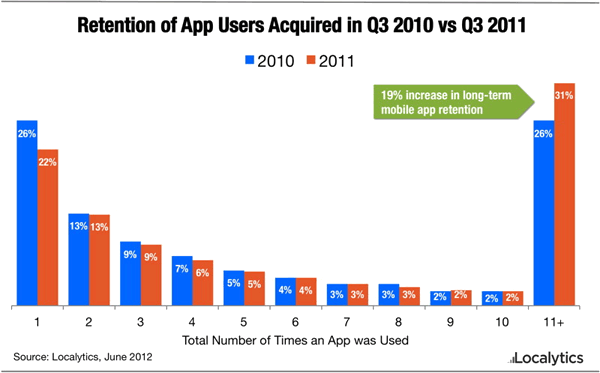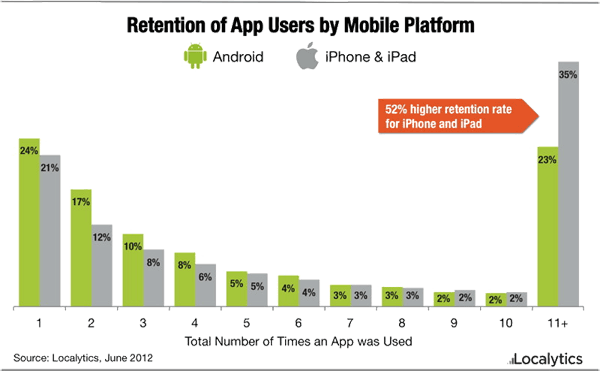How many times has a user run your program?
Localytics, the largest developer of tracking modules for mobile applications, collects data from 300 million smartphones and tablets. The other day, the company published some of the general statistics for the entire subscriber base , some of the numbers are very curious - at least they have never been seen before.
The first diagram shows the number of times the user launches each application. The number of programs (more precisely, installations) that run only once during the year decreased from 26% to 22%.

On the other hand, the percentage of applications that have switched to long-term use (11 or more launches) for the year increased from 26% to 31%.
The Localytics module works only in a separate program and can not say anything about the total number of applications on the phone. But there are Nielsen survey data that indicate an increase in the average number of applications on each device from 32 to 41, and their share in user time consumption has grown from 73% to 81%, leaving the browser crumbs.

Thus, there is a clear strengthening of the position of mobile applications in the lives of users. The number of applications on each smartphone / tablet is growing rapidly, their quality is also increasing, and users spend more and more time with them. What can I say, if the browser on mobile devices takes only 19% of the user's time - everything else goes to the applications.
According to Localytics statistics, applications for iOS are one and a half times more likely to switch to “long-term use” than applications on the Android platform (35% versus 23%). Unfortunately, Localytics experts cannot explain why there is such a significant difference. They suggest that this is due to the duration of use of the device itself .

The first diagram shows the number of times the user launches each application. The number of programs (more precisely, installations) that run only once during the year decreased from 26% to 22%.

On the other hand, the percentage of applications that have switched to long-term use (11 or more launches) for the year increased from 26% to 31%.
The Localytics module works only in a separate program and can not say anything about the total number of applications on the phone. But there are Nielsen survey data that indicate an increase in the average number of applications on each device from 32 to 41, and their share in user time consumption has grown from 73% to 81%, leaving the browser crumbs.

Thus, there is a clear strengthening of the position of mobile applications in the lives of users. The number of applications on each smartphone / tablet is growing rapidly, their quality is also increasing, and users spend more and more time with them. What can I say, if the browser on mobile devices takes only 19% of the user's time - everything else goes to the applications.
According to Localytics statistics, applications for iOS are one and a half times more likely to switch to “long-term use” than applications on the Android platform (35% versus 23%). Unfortunately, Localytics experts cannot explain why there is such a significant difference. They suggest that this is due to the duration of use of the device itself .

Methodology
Statistics for the III quarter. 2010 corresponds to the applications that were installed in the III quarter. 2010, and the number of starts is calculated from the moment of installation until March 15, 2011.
Statistics for the III quarter. 2011 corresponds to the applications that were installed in the III quarter. 2011, and the number of starts is calculated from the moment of installation until March 15, 2012.
Statistics for the III quarter. 2011 corresponds to the applications that were installed in the III quarter. 2011, and the number of starts is calculated from the moment of installation until March 15, 2012.
